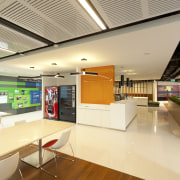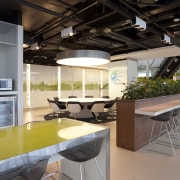Leading by example
Consolidation is an increasing focus for large corporations and banks. As well as streamlining customer services, it provides an ideal opportunity to tailor the workplace to the 21st century
Successful businesses often find that rapid expansion comes at a cost in terms of housing staff. These days, it is common to have staff spread over multiple locations, which has resulted in many large firms looking to consolidate their premises.
Standard Chartered Bank (SCB) in Singapore was no exception. The bank, which has just opened the largest trading facilities in Asia, was spread over 14 locations in Singapore and chose to consolidate its operations. Jones Lang LaSalle was appointed as its real estate advisor to secure the bank's long-term occupancy in two key locations a hub in the Changi Business Park and a front office in the Marina Bay Financial Centre with additional space retained at 6 Battery Road. Chris Archibold, head of markets at Jones Lang LaSalle, says the choice of building for both the front office and the operating centre was driven by a need to facilitate new, innovative and efficient ways of working.
Addressing these issues was a key focus for the bank, which recognises that the workplace has evolved. Driven by new technologies, the need for increased efficiencies, and a recognition that staff are a company's biggest asset, the modern workplace is much more streamlined, flexible and holistic than in the past and less hierarchical.
SCB commercial director of corporate real estate services Steve Riley says the bank consequently required an open work space conducive to staff interaction and communication.
"The ratio of space allocated to workstations and communal areas needed to change," he says. "We wanted to give more emphasis to the communal areas and encourage staff to use these work spaces are not restricted to desks."
As a result, the Changi operation and recently opened Marina Bay offices featured on these pages were designed to enhance communication within and across business units, and to future-proof the workplace.
Woodhead regional principal Andrew Carmichael says both offices have an open architecture and layout to promote teamwork. For example, meeting rooms are glazed and internal staircases with glazed balustrading provide transparency between floors. Offices were also designed on a modular grid to enable easy reconfiguration and to minimise construction wastage.
"Basing the design on a single module provides plenty of flexibility," Carmichael says. "It allows for a half module, quarter module or double module to be created for all room types. The office is a lot more efficient in terms of real estate. The design also reflects a shift in the workplace culture. As well as providing a much more collaborative environment, the design is not hierarchical. There are few executive offices most of these have been replaced by open desks."
The fit-out provides a 30% increase in communal space from previous offices. This includes a breakout lounge for all staff, and open meeting areas, called interchange hubs, on each floor. It also offers wireless networks and a hot-desk system for a mobile workforce.
The Marina Bay office, which covers 24 floors, continues the design theme introduced to the Changi office. In recognition of the multicultural nature of the workforce, there are three clear colour and material palettes Asian, African and Middle Eastern. Each floor features furnishings, carpets and wall murals in keeping with its particular theme.
Sustainability was another key design driver, with the bank committed to environmentally responsible design and practices. The base building of the Marina Bay office has been awarded Greenmark Gold status and SLB is looking to acquire a LEED CI Gold Award for the interior fit-out. And wherever possible, local materials and products were specified all interior products were chosen with consideration of the green component in their manufacture.
The interior has been designed to maximise natural light wherever possible, and lighting sensors are employed to minimise energy consumption.
SCB has also reduced paper use, through the introduction of centralised follow-me printing and recycling centres, which mean pages are printed by staff on arrival at a printer. There are also fewer printers on each floor to discourage over-use.
The need to promote sustainable design was a key reason the design team chose to expose the building's services in communal staff areas. Carmichael says the design saves on materials and also creates a very open interior that reflects the nature of the new workplace.
Credit list
Interior designer
Project manager
Quantity surveyor
Lighting consultant
Tiling
Veneers
Lighting
Office chairs
Breakout furniture
Meeting room chairs
Interchange sofas
Fit-out contractor
Mechanical and electrical engineer
Fire consultant
Glazed partitions
Blinds
Carpets
Paints
Workstations
Bar stools and café chairs
Lounge furniture
Learning chairs
Kitchen equipment
Story by: Colleen Hawkes
Home kitchen bathroom commercial design
Connected to the ocean
Transcending trend
Simplified seclusion















